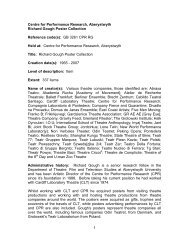IGES Newsletter Issue 2 - Aberystwyth University
IGES Newsletter Issue 2 - Aberystwyth University
IGES Newsletter Issue 2 - Aberystwyth University
Create successful ePaper yourself
Turn your PDF publications into a flip-book with our unique Google optimized e-Paper software.
I n s t I t u t e o f Ge o G r a p h y & ea r t h sc I e n c e s<br />
<strong>IGES</strong> <strong>Newsletter</strong><br />
Contents<br />
Page 2: Welsh welcome<br />
Page 3: A close escape<br />
Page 5: Field techniques<br />
Page 7: Travel awards<br />
Back cover: Hambrey Cliffs<br />
Geography Matters<br />
On the 18th of December 2004, I travelled to Sri Lanka<br />
for my Dad’s wedding. The first week of the holiday<br />
was spectacular; we visited the Cinnamon islands and our<br />
hotel at Bentota Beach in Bentota was an old Dutch Fort.<br />
The hotel was flanked on one side by the sea and on the<br />
other by a lake.<br />
After a filling Christmas dinner and a party the evening<br />
before, most hotel guests (including ourselves) arose later<br />
than usual for breakfast on<br />
Boxing Day. The restaurant<br />
area, which faced the lake,<br />
looked calm as ever. After<br />
breakfast, my brother and I<br />
headed to the pool to meet<br />
his friend. As they played<br />
about in the pool I looked<br />
out to the sea (some 20<br />
metres away) and noticed<br />
that the sea was further<br />
out than normal and eerily calm. To begin with, I thought<br />
nothing of it; but ten minutes later I began to realise what<br />
was happening when water began surging its way into the<br />
hotel grounds. I began to shout at everyone to get out of the<br />
pool because a tsunami was going to hit us. My family and<br />
the other guests climbed frantically to the fifth floor of the<br />
hotel and the elephants in the grounds were moved to the<br />
third floor reception.<br />
My dad and I ran to the wall outside of the restaurant from<br />
where the sea was just visible. We watched the tsunami<br />
approach, climb the beach and smash through the lower<br />
levels of the hotel. Next door to us was a smaller hotel<br />
facing the lake and we watched in total horror as a second<br />
wave crashed through, completely destroying it. I remember<br />
yelling at the hotel staff tying up the pontoon, “Move! Move!<br />
It’s in the lake! Move!” The wave, which had destroyed an<br />
entire hotel, was now moving back towards us from the<br />
lake. The look on everyone’s faces will stay with me for my<br />
Knowledge of geography can save lives. Hannah Lees had learned what<br />
the warning signs of a tsunami were in A Level Geography and on Boxing<br />
Day 2004 she saved many lives. Hannah’s Hotel “the Old Dutch Fort” was<br />
www.aber.ac.uk/iges<br />
1<br />
Winter 2007 Vol 1. <strong>Issue</strong> 2<br />
by Hannah Lees<br />
Year 2 BSc Geography Student<br />
entire life as we stood frozen waiting for the<br />
tsunami to hit us from the lake. The question<br />
on everyone’s mind was, “Would the hotel stay<br />
standing with the sea hitting us on one side<br />
and the lake from the other?”. I felt the wall<br />
shudder as the full force of the wave from the<br />
lake hit it. We were some of the lucky ones. Our hotel stood<br />
the ultimate test and as the waters resided the full scale of<br />
the damage and devastation was revealed.<br />
After the tsunami many of the hotel guests headed to<br />
Colombo Airport. My family and I decided to stay put and<br />
help the staff with the clean up operation. On New Year’s Eve,<br />
one of the senior staff members thanked us all for our help as<br />
without guests the hotel would not be open and they would<br />
not get paid. They needed the money more than ever now.<br />
That night I wrote my personal statement for the <strong>University</strong><br />
of Wales <strong>Aberystwyth</strong>. The events of my holiday had shown<br />
me how important geography was and how my knowledge<br />
about physical processes had helped me to recognise and<br />
react to the situation as it happened around me. I will never<br />
forget Sri Lanka or the events of December 26th 2004 as they<br />
hold a special place in my heart. The sea has always been one<br />
of my favorite parts of nature and the tsunami has given me<br />
a greater respect for it.<br />
solidly built with foundations in bedrock the hotel next door, which was<br />
completely destroyed, had its foundations on alluvial silt. Hannah is<br />
currently a second year <strong>IGES</strong> Undergraduate.
UNDERGRADUATE PERSPECTIVES<br />
Gareth Thomas Travel Scholarship sends Mills to Dublin<br />
From Sarah Mills<br />
<strong>IGES</strong> Masters Student (<strong>IGES</strong> BA Geography Graduate)<br />
With the help of a Gareth Thomas<br />
Travel Scholarship*, I undertook<br />
a trip to Dublin, Ireland this<br />
September. As well as having the<br />
opportunity to explore the city<br />
and meet local people, this visit<br />
also provided me with several<br />
geographical case-studies relating<br />
to themes in contemporary human<br />
geography.<br />
As a city with an increasing<br />
‘split personality’ between its<br />
cosmopolitan European identity,<br />
and its very traditional pre-<br />
EU identity, I found Dublin a<br />
fascinating place to explore. Its<br />
compact and geographically small area meant that it took very little time<br />
to familiarise myself with the city. There was a sense that locals bumped<br />
into each other on the street, highly unusual for a country’s capital, especially<br />
compared to previous travels to Paris or Rome. The city has had a turbulent<br />
and often oppressive past, yet Dubliners seem to have retained a strong<br />
sense of pride and identity. The city’s uniqueness is somewhat under threat<br />
from the EU regeneration, which is transforming Dublin into a modern,<br />
vibrant and sophisticated city.<br />
Dublin seemed a city of contrasts, one experience I had seemed to sum-up<br />
its new internal conflict. I observed a stereotypical old Irish gentlemen in a<br />
A warm Welsh welcome<br />
From Marie-Eve Lemieux<br />
<strong>IGES</strong> 3rd Year Exchange Student from McGill <strong>University</strong><br />
I’m sitting at my desk in Montréal, January 2005, looking out of<br />
the window at the white fluffy snow falling down. I take another<br />
look at the yellow and purple <strong>University</strong> website on the computer<br />
screen and dream again. It was almost a year ago now. As a student<br />
in the McGill School of Environment I wanted to complete my<br />
undergraduate degree with an experience abroad. I chose to study<br />
in <strong>Aberystwyth</strong> at <strong>IGES</strong>, particularly within the Centre of Glaciology.<br />
After a 24 hour flight from Montreal (Canada) to London, I finally got<br />
the train to <strong>Aberystwyth</strong>. As the train rolled closer to Wales, I noticed<br />
the landscape changing, until all I could see for miles around was<br />
green hilly pastures dotted with white sheep. Occasionally, to my<br />
pleasant surprise, the tops of those hills were covered by a forest<br />
of tall wind mills. Upon arriving, despite the weariness of the trip, I<br />
deposited my luggage in my new flat, and promptly ran down the<br />
hill to see for real the Irish Sea.<br />
I’m writing this text exactly mid-way through my exchange programme.<br />
I’ve had the great opportunity to meet the researchers at the Centre of<br />
Glaciology. I only wish I had time to take more modules. I was happy to get<br />
the chance to work with Dr. Essery and Dr. Lucas. We have installed an eddy<br />
covariance tower in Penglais Woods across the road from the <strong>University</strong>. The<br />
aim of the project is to use an energy budget, to explore the relationships<br />
between precipitation, cloud cover and solar radiation. All this information<br />
will then be included in an already existing database of Penglais Woods,<br />
using GIS.<br />
Owing partly to my background at the McGill School of Environment, I did<br />
not want to strictly focus on the scientific side of everything. I need some<br />
way to relate the science to daily life or to find relevant applications. I was<br />
2<br />
flat cap drinking Guinness in a corner of a pub with traditional Irish music<br />
playing in the background. To me this seemed a ‘postcard’ image of Dublin.<br />
However, it also seemed surreal that he paid for his drink in Euros, was served<br />
by a Greek barman and next door to this pub was a Starbucks coffee house.<br />
I questioned whether the place of Dublin has lost some of its distinctiveness<br />
with the increasingly European agenda, or whether this blend of tradition<br />
and cosmopolitanism was creating a more diverse, exciting, multicultural<br />
capital city.<br />
After exploring and getting to know Dublin as a city, and meeting the<br />
people that make Dublin so friendly and welcoming, I am very grateful to<br />
<strong>IGES</strong> for being awarded a Gareth Thomas Travel Scholarship. I feel that I<br />
have benefited academically with a widening of my cultural and political<br />
knowledge of our closest neighbour. This trip has complimented and added<br />
to my geographical imagination and has given me a greater understanding<br />
not only of Dublin and Ireland, but of some of the themes and processes that<br />
are played out in places, and I hope this will help me in my postgraduate<br />
studies this year.<br />
* Generous bequests from Mr Gareth Thomas and Dr Elwyn Davies, both former<br />
students who became lecturers in Geography at <strong>Aberystwyth</strong>, fund travel<br />
scholarships reserved for Geography students at <strong>Aberystwyth</strong>. Ten scholarships<br />
valued at £400 each and three at £70 each are awarded annually enabling<br />
students to travel and use this experience to broaden their geographical<br />
education. Sarah Mills completed her BA Geography degree in July 2006 and<br />
is currently undertaking an MA this year (Space, Place and Politics) and then<br />
onwards and upwards to a PhD.<br />
therefore quite keen to attend Dr. Whitehead’s lectures. His lectures gave me<br />
a perspective on sustainable societies within a European context. The more<br />
time I spend in the UK and learn about the politics of the country, the more I<br />
realise the importance of sustainable development.<br />
Prior to coming to Wales, I had heard a lot about Wales and the warm Croeso<br />
(Welcome). Wales and <strong>Aberystwyth</strong> definitely grow on you. I have joined<br />
the walking club and spent several weekends away, enjoying breathtaking<br />
views atop the summits of Cadair Idris, the Brecon Beacons and Snowdon:<br />
warm tea, wet feet… because it does rain in Wales! But this is a minor detail<br />
considering the great people I’ve met. I’ve also become an international<br />
student with the Guild of Students. Being on exchange I could have<br />
travelled extensively outside Wales and tried to see as much as possible, but<br />
coming back to Canada I would have felt that I had missed the best things<br />
<strong>Aberystwyth</strong> has to offer: flatmates, classmates, staff, and the dynamism of<br />
the <strong>University</strong>.
Teaching Notes<br />
Employment after Graduation<br />
From Dr John Grattan (jpg@aber.ac.uk)<br />
<strong>IGES</strong> students do better than the national average when it<br />
comes to employment in the first six months after graduation:<br />
88.2% of those seeking work were employed compared to<br />
85.9% nationally in 2005. But these figures do not tell the<br />
whole story. <strong>IGES</strong> graduates are obviously a clever lot; in 2005<br />
38% of our graduates went on to study for postgraduate<br />
qualifications against a national average of 18%.<br />
Mock Earth Summit<br />
From Dr Mike Woods (zzp@aber.ac.uk)<br />
Human Geography students saved the world again (in principle), at<br />
the annual ‘Mock Earth Summit’! The first-year students managed<br />
to save the planet over just one October weekend, while attending<br />
an <strong>IGES</strong> new student induction programme. The event was hosted<br />
at the <strong>University</strong>’s residential centre, Gregynog Hall, in mid Wales.<br />
The mock-Tudor country house is set in acres of beautiful<br />
parkland and was the perfect forum for the over forty first year<br />
Human Geography students to hash out some of the world’s most<br />
challenging issues. Students formed teams representing different<br />
countries and negotiated an agreement on carbon reduction. After<br />
preparing their positions in bilateral discussions (with a roving TV<br />
news team trying to scoop the latest developments), the teams<br />
came together to make their presentations and hammer out a<br />
compromise.<br />
As well as introducing some of the key concerns of contemporary<br />
Human Geography – responding to climate change, global<br />
inequality, and geopolitics – the mock summit is a great<br />
opportunity for first year students to get to know each other and<br />
members of staff, with plenty of free-time to explore Gregynog’s<br />
spacious grounds and make use of its first-rate facilities.<br />
3<br />
The Most Satisfied Geography and Environmental<br />
Science Students In Britain – Official!<br />
From Dr Mike Woods (zzp@aber.ac.uk)<br />
<strong>Aberystwyth</strong> has Britain’s most satisfied Geography and Environmental<br />
Science students, the 2006 National Student Survey has found. Final year<br />
students in the Institute of Geography and Earth Sciences completing<br />
the survey gave us:<br />
• The highest overall satisfaction rating in Human Geography for<br />
any university in Britain with a score of 4.6 out of 5.<br />
• The joint highest overall satisfaction rating in Physical<br />
Geography and Environmental Science for any university in<br />
Britain with a score of 4.5 out of 5.<br />
The <strong>University</strong> of Wales, <strong>Aberystwyth</strong>, as a whole topped the National<br />
Student Survey results in Wales and came fifth across Britain. The<br />
Director of the Institute of Geography and Earth Sciences, Professor<br />
Martin Jones commented: “<strong>IGES</strong> is immensely proud that our students<br />
have rated us so highly in this satisfaction survey. We are a researchled<br />
department striving to produce the highest quality of learning<br />
environment and resources to make sure that our students have the<br />
best start to their adult lives. This indicates the professionalism and<br />
enthusiasm of staff, our dedication to the quality of teaching and<br />
support services, and the participatory and interactive nature of the<br />
student experience. <strong>Aberystwyth</strong> is a unique place to study and we are<br />
totally committed to providing the best possible experience for our<br />
students.”<br />
The National Student Survey is an annual, independent, survey of<br />
student satisfaction commissioned by the government’s Funding<br />
Councils for Higher Education and supported by the National Union<br />
of Students.<br />
Further details on the survey can be found on the Teaching Quality<br />
Information website at: www.tqi.ac.uk<br />
A Close Escape<br />
From Dr John Grattan (jpg@aber.ac.uk)<br />
On our most recent student field trip to New<br />
Zealand, we visited the ruins of a home which<br />
had a volcanic fumarole open up underneath it!<br />
The elderly owner thought there was nothing<br />
amiss with having a very hot floor and adopted<br />
the habit of drying her clothes by spreading<br />
them out on the carpet. She narrowly avoided<br />
death by gas poisoning though, the heat forced<br />
her to sleep with all the windows open! We actually stay nearby at the<br />
KiwiPaka Hostel, which has its own volcanic plumbing – here put to<br />
good use to heat the hot-tub.
NEW MEMBERS OF STAFF<br />
<strong>IGES</strong> staff continues to grow!<br />
from Professor Martin Jones (Head of Department)<br />
As part of our continued expansion as a world-class research and teaching centre in<br />
Geography and Earth Science, we are very pleased to introduce the following new staff,<br />
who joined <strong>IGES</strong> since the last <strong>Newsletter</strong>:<br />
Dr James Brasington joined <strong>IGES</strong><br />
this January from the <strong>University</strong> of<br />
Cambridge as a Reader in Physical<br />
Geography. His academic interests focus<br />
on the development of numerical models<br />
and earth observation techniques to<br />
study and predict the behaviour of<br />
catchment and fluvial systems over a<br />
wide range of time and space scales.<br />
Geographically his research spans a<br />
diverse range of environments from the<br />
hot and dry (Iraq, California) to the warm<br />
and wet (Nepal) and the cool and humid<br />
(Scotland, New Zealand). Outside work, James is a keen hill walker, enjoys<br />
running and has recently turned to triathlon, although is struggling not to<br />
drown in the process! He is looking forward to moving from the flatlands of<br />
East Anglia to finally see some hills from his window!<br />
Professor Mathew Hannah joins <strong>IGES</strong><br />
this summer from the <strong>University</strong> of<br />
Vermont (Burlington, Vermont, USA) as<br />
a Professor in Human Geography. Matt’s<br />
primary research interests concern the<br />
ways in which modern forms of power,<br />
knowledge and territorial organization<br />
constitute each other and underpin<br />
Western social orders. His studies have<br />
focused on the spatial prerequisites for<br />
administrative control of Native Americans by the US Government in the<br />
late 19th century, the modernization of the US Census as both a symbol and<br />
a vehicle of new forms of spatial governance during that time period, and<br />
most recently, West German Census boycott movements in the 1980s as a<br />
window on emergent forms of citizenship appropriate to the ‘Information<br />
Age’. Away from the office, he is an avid walker and near-fanatical, year-round<br />
disc golfer.<br />
Glacier Web (www.glaciers-online.net)<br />
With support from UWA’s Teaching Innovations Fund, Professor Mike<br />
Hambrey (mjh@aber.ac.uk) of <strong>IGES</strong>, has been working jointly with Dr<br />
Juerg Alean from Zurich, Switzerland, to develop an educational website<br />
about glaciers (www.glaciers-online.net).<br />
The website is based on their very successful book (Hambrey &<br />
Alean, Glaciers, Cambridge <strong>University</strong> Press) and includes most of the<br />
photographs published therein. The site is hosted by ‘SwissEduc’, which<br />
is a rapidly expanding site covering geography and other academic<br />
disciplines. It is supported by charitable foundations in Switzerland. The<br />
purpose of the website is to help secondary level and university students<br />
4<br />
Dr Allen Hubbard joined <strong>IGES</strong> this<br />
January as a Lecturer in Physical<br />
Geography. Allen is interested in<br />
the links between glaciers and<br />
ice sheets and global climate on<br />
a variety of temporal and spatial<br />
scales. Allen’s particular expertise<br />
focus on the collection and use<br />
of field-measurements to train<br />
high-resolution, 3D models of<br />
climate, ice sheet and geophysical<br />
dynamics to help unravel the<br />
multitude of interactions and feedbacks which govern this aspect of the<br />
earth-system and which can lead to complex, non-linear responses and<br />
rapid environmental change. Allen has been most fortunate to have been<br />
able to combine some of these research themes with a passion for highlatitude<br />
sailing and mountaineering. In the last 7 years he has been sailing off<br />
in his own steel ketch, which has taken him from the Arctic to the Antarctic<br />
and lots of very pleasant (and warm!) places in between. For those of you<br />
wondering; yes, Allen is the brother of <strong>IGES</strong>’s Dr. Bryn Hubbard, and yes they<br />
are both great glaciologists.<br />
Dr Damià Vericat joined <strong>IGES</strong> this<br />
January, from the Forestry and<br />
Technology Centre of Catalonia<br />
(Spain) as a Post-Doctoral Researcher<br />
for the Centre for Catchment and<br />
Coastal Research. Damià is a fluvial<br />
geomorphologist whose research is<br />
primarily concerned with monitoring<br />
and modelling fluvial dynamics,<br />
especially sediment transport (bedload and suspended load) in gravel bed<br />
rivers, sediment and water management in regulated rivers, and fluvial<br />
hydrology. Recently his interest was focused on macroinvertebrate drift and<br />
bedload transport interactions in gravel patchy rivers in collaboration with<br />
the <strong>University</strong> of Lleida (Catalonia, Spain), the Forestry and Technology Centre<br />
of Catalonia (Catalonia, Spain) and the <strong>University</strong> of Aberdeen (Scotland, UK).<br />
Damià’s main hobbies are mountain biking, football, enjoying nice films in<br />
cinemas, and cooking.<br />
gain a visual appreciation of glaciers, glacial landforms and sediments,<br />
and their importance in the context of climate change. <strong>Aberystwyth</strong><br />
students are encouraged to use the site for glacier-related modules. The<br />
site is also used by university lectures world-wide to incorporate images<br />
into their own course, and some photographs have been used by BBC<br />
News Online. The website received a very positive review in the journal<br />
Science in 2005, which described it as ’a boon for visual learners’. The site<br />
continues to evolve – new additions last autumn included an illustrated<br />
glossary of glacial features, and a collection of Arctic photographers.
OFF THE BOOKSHELF<br />
‘Fuel for Free’<br />
Wearing his trans-disciplinary hat, engineer<br />
and postgraduate political geographer<br />
Kelvin Mason (kjm04@aber.ac.uk) has<br />
written a practical guide for small-scale<br />
brick-makers and development field<br />
workers. The guide confronts prevalent<br />
ideas of both development and the<br />
environment. Fuel For Free presents an<br />
overview of the use of wastes as fuels and case studies from<br />
the experience of ITDG/Practical Action in Peru, Zimbabwe and Sudan.<br />
‘Benchmark paper<br />
in Hydrology’<br />
One of Professor Tony Jones’s (jaj@<br />
aber.ac.uk) early research papers,<br />
published in Water Resources Research,<br />
has been selected as a benchmark<br />
paper in hydrology by the International<br />
Association of Hydrological Sciences. The<br />
paper introduced soil piping to hydrological<br />
theory and proposed that flow through these subsurface<br />
pathways can make an important contribution to stormflow in rivers.<br />
Previous theory maintained that only water flowing over the surface was<br />
a significant source of flood flows in rivers.<br />
Subsequent field experiments have confirmed the hypothesis, with<br />
around 50% of discharge in part of the upper Rheidol catchment being<br />
supplied by soil pipes. The paper is one of just 31 selected papers<br />
published since the ground-breaking work of Robert Horton in 1933<br />
that initiated modern scientific hydrology.<br />
It is reprinted in the IAHS Benchmark Papers in Hydrology Series (2006)<br />
with a commentary by Professor Keith Beven of Lancaster <strong>University</strong>.<br />
‘Encyclopedia of<br />
Quaternary Science’<br />
November 2006 saw the publication of the stunning<br />
4-volume Encyclopedia of Quaternary Science, to<br />
which our own Dr Helen Roberts and Professor<br />
Ann Wintle were invited to contribute entries.<br />
Printed in colour, the encyclopedia is written by a<br />
team of leading experts in the field of Quaternary<br />
Science, and designed to be “an essential reference<br />
for scientists, students, and others” studying this important period of the<br />
last 1-2 million years of the Earth’s history. The articles are pitched at a<br />
level which makes the material accessible to undergraduate students,<br />
whilst also providing researchers with the most up-to-date information.<br />
Don’t just take our word for it though - check it out for yourself at the<br />
library (or visit http://www.books.elsevier.com/eqs).<br />
5<br />
‘The Nature of the State’<br />
Written by three members of human<br />
geography staff in <strong>IGES</strong> (Dr Mark<br />
Whitehead, Dr Rhys Jones and<br />
Professor Martin Jones), and<br />
published in the Oxford Geographical<br />
and Environmental Studies series<br />
(Oxford <strong>University</strong> Press), The<br />
Nature of the State challenges<br />
the ways in which geographers<br />
and social scientists approach<br />
the study of state-nature<br />
relations. The authors analyse<br />
different instances of statenature<br />
interaction from all over the world,<br />
considering the geo-politics of resource conflicts, the operation o f<br />
natural history museums, the organizational practices of<br />
environmental departments and ministries, the regulation of genetic<br />
science, and contemporary forms of state intervention within issues<br />
of climate change.<br />
‘Field Techniques in<br />
Glaciology and Glacial<br />
Geomorphology’<br />
All geography and earth science students<br />
carry out fieldwork as part of their studies,<br />
either on supervised field courses or<br />
independently as part of an extended<br />
project. Field Techniques in Glaciology<br />
and Glacial Geomorphology, by<br />
Professor Neil Glasser (nfg@aber.<br />
ac.uk) and Dr Bryn Hubbard (byh@<br />
aber.ac.uk) of <strong>IGES</strong>, provides students<br />
with accepted and practicable field techniques for<br />
research in glaciology.
Research Notes<br />
device designed at <strong>IGES</strong> to remove toxic metal<br />
A pollution from water flowing from disused<br />
mines was the winner of the National Energy<br />
Globe award for the United Kingdom. The award<br />
is in recognition of leading work on the BIOMAN<br />
project headed by Dr. Bill Perkins (wwp@aber.<br />
ac.uk), Dr. Nick Pearce and <strong>IGES</strong> postgraduate<br />
and research assistant Suzanne Hartley. BIOMAN<br />
(BIOabsorption of Metals from Abandoned miNe<br />
sites) is a €1.4m€ Life Environment funded project<br />
led by the <strong>University</strong> of Wales, <strong>Aberystwyth</strong> and in<br />
collaboration with researchers from the <strong>University</strong><br />
of Bologna and the <strong>University</strong> of Sheffield.<br />
The device consists of a large tea bag-like structure<br />
filled with dealginated seaweed (a by-product of an<br />
industrial process to make food additives) housed<br />
in a water tank. Bioman has been undergoing field<br />
trials in mid Wales and Italy. Key to the process is<br />
the dealginated seaweed’s ion-exchange capacity.<br />
Initial laboratory tests and the field trials completed<br />
to date have shown that dealginated seaweed is<br />
very effective at trapping the principal mine water<br />
pollutants such as zinc, lead and cadmium, as the<br />
water flows through the tank. The Energy Globe is<br />
awarded to projects from all over the world which<br />
make careful and economical use of resources and<br />
employ alternative energy sources. Every year, about<br />
700 projects from all over the world are submitted<br />
in the Energy Globe Award competition.<br />
Dr Peter Wyn-Jones (pyw@aber.ac.uk), of <strong>IGES</strong>’s<br />
Centre for Research into Environment and Health<br />
(CREH) has been appointed by the Office of Science<br />
and Technology (http://www.dti.gov.uk/science/)<br />
to be a UK representative to the management<br />
committee on the EU COST Action 929 project<br />
titled ‘A European Network for Environmental and<br />
Food Virology’. Action 929 seeks to strengthen the<br />
area of food and environmental virology in Europe.<br />
They seek to establish systems for effective European<br />
responses to viral hazards associated with food and<br />
environmental contamination. Dr Wyn-Jones will<br />
represent UK interests as the programme develops.<br />
An anthropogenic origin for hummocky<br />
moraine sediment-landform assemblages<br />
Recent ground works at the <strong>University</strong> of Wales, <strong>Aberystwyth</strong> has revealed<br />
startling new evidence supporting an entirely new formation mechanism for the<br />
development of ‘hummocky moraine’ topography. High-resolution remotely sensed<br />
digital imagery has shown that a excessive use of poorly consolidated ground can<br />
rapidly lead to the establishment of highly mineragenic swamp conditions. This<br />
process is compounded by the contemporaneous and dramatic reduction of ground<br />
vegetation, formerly Festuca rubra. Alleviation of swamp-like conditions through the<br />
rapid aggredation of a series of sandy-gravel mounds has lead to the formation of a<br />
generic hummocky moraine topography.<br />
Remotely-sensed imagery<br />
showing evidence of<br />
anthropogenic origins<br />
of hummocky moraine<br />
sediment-landform<br />
assemblages at ‘temporary’<br />
car park on Penglais<br />
Campus, <strong>University</strong> of Wales,<br />
<strong>Aberystwyth</strong>.<br />
Spoof provided by<br />
S.L. Roberson and E.A. Sahlin.<br />
6<br />
It is proposed that via the process<br />
of ‘laying-off’, prolonged neglect<br />
can result in the establishment<br />
of landforms typical of formerly<br />
glaciated landscapes (Hambrey<br />
et al., 1997). This new process<br />
provides evidence supporting<br />
the hypothesis that Scottish land<br />
clearances during the seventeenth<br />
and eighteenth centuries resulted<br />
in the widespread formation<br />
of non-glaciagenic hummocky<br />
moraine-like sediment landform<br />
assemblages.<br />
Dr Mohammed Umer, Associate Professor at the Department<br />
of Earth Sciences at Addis Ababa <strong>University</strong>, has been<br />
appointed to an Honorary Departmental Fellowship in the<br />
Institute of Geography and Earth Sciences. This marks the vital<br />
role Mohammed has played in research collaboration with<br />
<strong>IGES</strong>‘s Quaternary Environmental Change Research Group<br />
over the last 12 years. Mohammed is a member of the scientific<br />
steering committee of the International Geosphere-Biosphere<br />
Programme’s PAGES (Past Global Changes) Pole-Equator-<br />
Pole transect through Europe and Africa, as well as PAGES<br />
representative for Ethiopia. He will next visit <strong>IGES</strong> in September<br />
2007, as part of the PalaeoTana project, investigating the<br />
Pleistocene history of the Blue Nile headwaters.
‘Scholarship Travel Awards send <strong>IGES</strong><br />
Postgraduates to Austria and United States’<br />
Blue Ridge mountains, South Carolina.<br />
The D.T.H. Price Postgraduate Scholarship<br />
Awards are a generous legacy to <strong>IGES</strong> from<br />
the estate of Mrs Ann Price. The scholarship is<br />
awarded annually to doctoral students who<br />
submit imaginative or worthy plans for enriching<br />
their understanding of Geography. This award<br />
provides an excellent opportunity for students to<br />
either (i) enhance their knowledge of comparative<br />
environments or (ii) to attend a conference<br />
and associated field excursions related to their<br />
research. This year, two awards were presented to<br />
Eva Sahlin and Matt Rowberry.<br />
One of <strong>Aberystwyth</strong>’s most distinguished<br />
Geography graduates returned in November<br />
to deliver the <strong>University</strong>’s annual J. B. Willans<br />
Lecture. Professor Nigel Thrift is widely<br />
recognised as one of the world’s leading human<br />
geographers. After graduating from <strong>Aberystwyth</strong><br />
in 1971, Professor Thrift followed a career that has<br />
taken him to universities in Canberra, Lampeter,<br />
Bristol and Oxford before being appointed as Vice-<br />
Chancellor of Warwick <strong>University</strong> in 2006. Professor<br />
’<br />
Eva Sahlin is a third-year doctoral student<br />
studying the dynamics and configuration of<br />
Welsh Quaternary glaciations in the <strong>IGES</strong> Centre<br />
for Glaciology. Eva took the opportunity to<br />
attend the 9th International Symposium on<br />
High Mountain Remote Sensing Cartography<br />
(HMRSC) in Graz, Austria where she gave a poster<br />
presentation titled “Geomorphological mapping<br />
in Wales, UK, based on remotely sensed data”.<br />
The conference enabled Eva to meet researchers<br />
in the same field whilst also learning about new<br />
computational techniques, applications and<br />
software. Photographic evidence for the trip<br />
seems to involve wine tasting in southeast Styria<br />
(while discussing the formation of the Alps, of<br />
course), the Italian Renaissance courtyard of<br />
Landhaushof and the new Art Museum in Graz.<br />
Who says physical geographers don’t also enjoy<br />
an occasional culture?<br />
Matt Rowberry is a final year doctoral student<br />
studying tectonic and climatic influences on<br />
Cenozoic landscape evolution in the Welsh region<br />
in the <strong>IGES</strong> River Basin Dynamics and Hydrology<br />
Research Group. The scholarship allowed Matt<br />
the opportunity to go into the field to compare<br />
and contrast models of long-term landscape<br />
evolution developed in Wales to those developed<br />
in the southern Appalachians, United States. This<br />
also enabled Matt to apply the theoretical model<br />
Thrift’s work has spanned interests ranging from<br />
economic geography to cultural studies, and has<br />
consistently been at the forefront of theoretical<br />
innovation in human geography and the social<br />
sciences more broadly.<br />
In his talk, entitled ‘Emotional Geographies: What<br />
and Why?’, Professor Thrift argued that emotions<br />
are becoming increasingly important in shaping<br />
modern commercial and political practices.<br />
7<br />
Cumberland Mountain, South Carolina.<br />
of landscape evolution that he hopes to present in<br />
his PhD thesis beyond the geographical confines<br />
of the region where it was conceived.<br />
Photographic evidence for the trip seems to invoke<br />
a lot of rock-gazing in thick coniferous forest.<br />
So did Matt actually leave Ceredigion? Well, a<br />
slight suntan and a red, peeling back suggested<br />
yes and, apparently, the beaches in South Carolina<br />
are well worth a visit too!<br />
Both Eva and Matt highlight their gratitude for an<br />
award that enabled them to work outside their<br />
immediate research area, be that academic or<br />
geographical. This scholarship provides a fantastic<br />
opportunity for future postdoctoral researchers<br />
and both recommend applying for the award<br />
wholeheartedly.<br />
Businesses design products that appeal to<br />
consumers’ emotions and seek to build emotional<br />
connections to their brands. Politicians and<br />
parties are packaged and promoted through the<br />
media in highly emotive ways. Understanding<br />
the contemporary world therefore requires<br />
understanding of the power of emotions, which<br />
in turn demands new research strategies from<br />
geographers and social scientists.
General Anouncements<br />
Grattan on TV again!<br />
(not just a re-run either)<br />
New place names in<br />
Antarctica linked to <strong>IGES</strong><br />
The Antarctic Place Names Committee has added the name Hambrey<br />
Cliffs to the map of James Ross Island in British Antarctic Territory. The<br />
location is 63° 52’ 30’’ S, 58° 06’ 00’’ W, and overlooks Whisky Bay which<br />
faces the Antarctic Peninsula. The 3 km long cliffs are named after<br />
Professor Mike Hambrey, Director of the Centre for Glaciology in <strong>IGES</strong>,<br />
in recognition of his work in glacial geology and glacial sedimentology<br />
in the Arctic and Antarctic. The cliffs are composed of a subglacial delta<br />
complex of volcanic debris (called hyaloclastite), overlain by basalt lava<br />
flows, and the sequence rests on soft Cretaceous sandstone. Sporadically<br />
developed between the sandstone and the volcanics is a thin layer of<br />
glacial sediment formed at the same time as the volcanic strata. It was<br />
here that Mike dislocated his shoulder in 2002 for the cause of science!<br />
Editors: Joseph W heaton (joe.wheaton@aber.ac.uk) & Catherine Bean (cbb@aber.ac.uk)<br />
Designed & Printed by Design & Printing Services, The <strong>University</strong> Of Wales, <strong>Aberystwyth</strong>. February, 2007.<br />
Institute of Geography and Earth Sciences<br />
The <strong>University</strong> of Wales, <strong>Aberystwyth</strong><br />
Llandinam Building, <strong>Aberystwyth</strong>, Ceredigion, SY23 3DB<br />
8<br />
John Grattan has appeared in two TV programmes in recent months.<br />
As reported in the last edition, on August 30th 2006 he was the Super<br />
Eruption expert in a 2 hour long ‘end of the world extravaganza’ broadcast<br />
by ABC news in the US. On January 19th 2007 the BBC’s Timewatch series<br />
broadcast a documentary largely based on John’s research into the eruption<br />
of the Laki Fissure volcano in Iceland. To John’s eternal embarrassment the<br />
documentary was entitled “Killer Cloud”, but at least his mum was pleased.<br />
Electronic copies of the Super eruption report John co-authored can be<br />
obtained by emailing him at jpg@aber.ac.uk. It is written in a very accessible<br />
style and ought to be useful for A level students.<br />
Professional Alumni Association<br />
We are hoping to make contact with graduates of the department<br />
who have moved into teaching and would like to join our Professional<br />
Alumni Association. We would love to hear of your own experiences as<br />
geography teachers. It is our intention to keep you up to date with the<br />
department’s news, to send you copies of research relevant to the school<br />
curriculum and we also hope to produce material based on our research<br />
which you can use in your teaching. Please contact Dr John Grattan at<br />
jpg@aber.ac.uk and let him know you are out there.<br />
Also honoured is Professor John Smellie (pronounced Smylie), who<br />
is Senior Volcanologist at the British Antarctic Survey in Cambridge,<br />
and a Visiting Departmental Research Fellow attached to the Centre<br />
for Glaciology. Smellie Peak, at 63° 55’ 54’’ S, 57° 55’ 12’’ W, is an isolated<br />
triangular peak about 695 m high, also on James Ross Island. It has a<br />
conspicuous deep red pyroclastic unit on the north face. Both John and<br />
Mike are working together on glacier-volcano interactions on this and<br />
adjacent islands, with a view to unravelling the evolution of the Antarctic<br />
Peninsula Ice Sheet and the local ice caps, in an area that is particularly<br />
susceptible to climatic change.<br />
General enquiries :Tel: 01970 622606


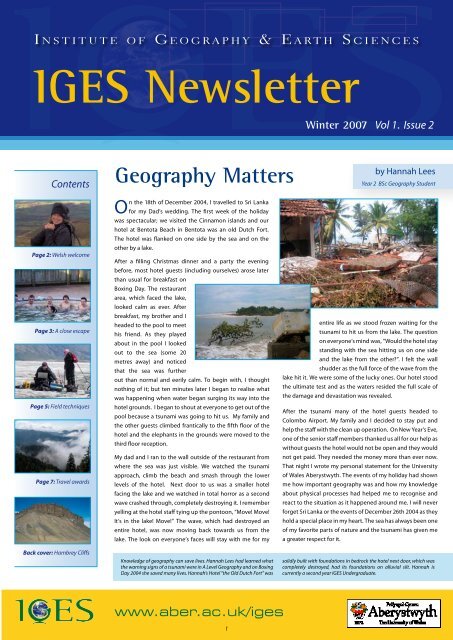
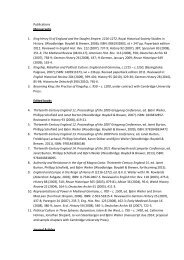
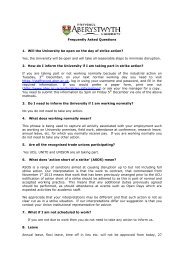




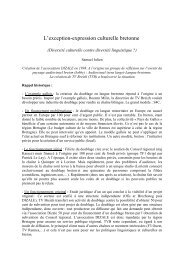

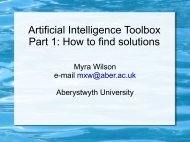
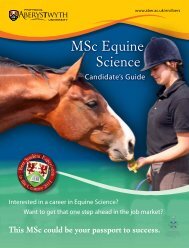

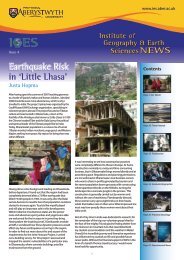
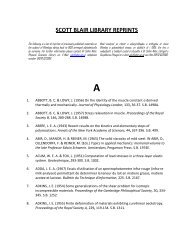
![[pdf] the council - Aberystwyth University](https://img.yumpu.com/8200062/1/184x260/pdf-the-council-aberystwyth-university.jpg?quality=85)
